Program of fundamental researches of the RAS Presidium |
|
REPORT for 2003-2005
Section 2: Development
of methodological basis for monitoring of biodiversity
Curator of the section: Academician
A.S. Isaev
Steady and unexhausted forest use should be oriented as resource and environmental management taking conservation of natural ecosystems and species diversity into account. This statement has an important significance for development of the national forest policy. Forest biodiversity monitoring is an integral part of this problem, considering observation of forest lands state for the purpose of detection, analysis and forecasting potential changes as due to natural processes as due to anthropogenic factors. In spite of great volume of available data on measured parameters of forest ecosystems the arrangement of forest monitoring is rather difficult task. This situation is explained because of the unified methods and universal units for biodiversity assessment are absent, as well these assessments are not integrated for biosystems of different spatial levels. For the methodological purposes scientific collectives of Moscow, Karelia, Komi, Krasnoyarsk, and Primorski Krai worked out following problems:
Contemporary state of forest biodiversity Russia is the forest country, possessing 25% world forest resources. So the conservation of forest diversity under their intensive economic use is considered as the most important national and global problem. The forest area was essentially reduced for last centuries, especially within southern and central parts of European-Urals region. The most serious change had occurred in the second part of XIX century. During last 50-years period deforestation has been stopped in Russia; and forest areas have been even increased because of some agricultural lands were given up and were forested while some bogged lands have been forested after melioration. At the same time qualitative structure of forests became essentially worse as in environmental and resource relation. Extensive areas of the best pine, cedar and spruce forests were cut as result of intensive exploitation; and these areas were covered by low-productive birch, aspen forests and coniferous plantations. Restoration of initial forest communities here will require serious forestry measures and very long time. Forest areas are subjected to great damage because of fires and pests, especially in Siberia and Far East. Here areas of dead forests are more than areas of cut forests. Especially negative impact of fires is observed in forest ecosystems of Eurasian North-East where burning extent is high and post-fire successions are extremely slow. It is obviously one of few boreal regions where specific “green deserts” are forming after intensive forest fires. These are extensive deforested areas covered with bush and grass vegetation. In order to improve forest management and protection it is necessary to have objective assessments of forest resource and environmental potentials in different natural and economic regions of country. Such assessments give an opportunity to determine permissible impact on forest ecosystems escaping the loss of their environmental functions. Practical realization of environmental principles of forest management requires deep knowledge of forest forming, their biodiversity and their connections with other biosphere components. Also paleogeographical features of forest cover forming and ecological and genetic characteristics of trees, bushes grass and mosses species should be taken into account. The most important feature of Russian forests is concluded in conservation of extensive natural forest stands not subjected to anthropogenic impact. Forest ecosystems conserved within large refuges have natural biodiversity level, so these are patterns of population, species, and ecosystems’ diversity. These forests are differed of cultural European forests and our forest plantations, which have low steadiness to unfavorable environmental factors. Development of national forest policy conserving biodiversity is difficult task. Thus development of methodology and forest use methods, their resource and environmental orientation have very important value. For example, for last two centuries dominating conception of forestry in Western Europe was aimed at maximal growth of productivity; this was only commercial approach. This resulted in full disappearance of virgin mixed coniferous and broad-leaved forests in Europe. Coniferous monocultures replacing virgin forests are less steady to unfavorable environmental factors. Methodology for assessment of forest biodiversity Scientific ideas about biodiversity were evolving as some stages. The initial interest in rare species inventory was changed by intensive researching ecosystem and communities diversity (Whittaker, 1972; Zonneveld, 1988; Franklin, 1993), accompanied by development of terms and approaches to assessment of biodiversity parameters (Magarran, 1992, Heywood 1995). By present the works on assessment of biodiversity have been fulfilled for territories of different level from large continent areas and large regions (Malyshev, 1994) up to small local areas. The next step is concluded in discovering factors determining biodiversity level; as well as we would like to determine what human community should do in order to conserve biodiversity and restore it. At present time a new scientific paradigm has formed in ecology sciences (including landscape theory and phytocenology). This paradigm considers mosaic structure of a landscape, hierarchical system of mosaics and correlation between spatial and temporary scales of these mosaics existing. Heterogeneous mosaic structure is considered as general attribute of living cover (Allen, Starr, 1982). Each biosystem level is characterized by own main factors determining biodiversity; and this one is measured by own parameters set. Methodology approach, used in the Project, is based on following statements:
As a result of fulfilled researches principally new methodological approaches and methods for monitoring of forest biodiversity had been developed. These results allow to research forest ecosystems in the process of age dynamics within the natural territorial complexes of different scale and complexity. This methodology had been successfully used in model regions (Central region, Karelia Republic, Murmansk oblast, Krasnoyarsk Territory and Primorsky Krai). Accumulated knowledge of researching biological systems as populations, species and communities allows to interpret data as territorial units of different scale and to understand spatial and temporary dynamics of forest areas under increasing human impact. In this connection we determined the hierarchy of spatial scales and adopted following spatial levels for forest biodiversity account: local, regional, federal. Knowledge of factors supplying ecosystem biodiversity on different spatial hierarchical levels is the base for development of nature management regimes preventing negative anthropogenic influence. Insufficient environmental and biological basis for concrete measures may result in unexpected negative consequences. Discovery of mechanisms for biodiversity supply is accompanied by increasing interest in modeling potential composition of biosystems. This may be initial point for assessment of biodiversity losses. Main results
|
||||||||||||||||||||||||||||||||||||||||||||||||||||||||||||||||||||||||||||||||||||||||||||||
Table 1. Groups of forest types. Northern taiga, European part of RF (Zaugolnova, Morozova, 2006) (http://mfd.cepl.rssi.ru/flora/) |
|||||||
Syntaxons in ecologic-floristic classification |
Sections (subsections) |
Dominants of upper layer |
|||||
Pine |
Spruce |
Larch (+pine, spruce) |
Betula pubescens |
Cedrus (+spruce, fir) |
Fir (+spruce, cedrus) |
||
Flavocetrario-Pinetum, Cladonio-Pinetum typicum, Cladonio-Pinetum pulsatilletosum |
Lichen |
- |
|||||
Cladonio-Pinetum vaccinietosum, Vaccinio-Pinetum |
Lichen |
||||||
Empetro-Piceetum, Eu-Piceetum myrtilletosum |
Green moss (schrubs) |
||||||
Eu-Piceetum dryopteridetosum |
Green moss (small grasses) |
- |
no data |
no data |
|||
Eu-Piceetum athyrietosum, Aconito-Piceetum |
Green moss (high grasses) |
- |
no data |
no data |
|||
Aconito-Piceetum |
Grassy |
- |
- |
- |
- |
||
Rubo chamaemoro-Piceetum |
Sphagnum (polytrichum-sphagnum) |
no data |
no data |
- |
|||
Carici loliaceae-Piceetum |
Sphagnum (hygrophilous-sphagnum) |
- |
no data |
no data |
no data |
- |
|
Oxycocco-Pinetum |
Sphagnum (schrubs) |
no data |
no data |
no data |
- |
||
Obtained
typological characteristics are compared in topographical situation and
succession state, thus this is effective form of semantic information which may
be used for interpretation of space images and forest inventory data. The
computer database has been formed, including list of forest vegetation
syntaxons for European Russia as well as database of geobotanical descriptions.
Now the works on database of main forest types of European Russia are
continued.
The researchers of the Institute of Biology and Soils of the RAS Far East Department have developed the classification of forests on the base of ecological analysis and indication methods for forest areas of Primorsky Krai.
Landscape approach to basing typological principles of natural spatial differentiation of forest cover has been used by scientists of the Forest Institute of the RAS Karelian Scientific Center. Forest cover of European taiga was differentiated for seven levels: landscape country, landscape zone, subzone, landscape region, landscape, landscape district, locality, habitat (within native biogeocoenosis). Made with using national landscape science ideas this hierarchical system of forest vegetation structural unites is adequate to their natural arrangement. The researches have resulted in detail description and assessment of biodiversity for virgin forest and forest swamp communities of Karelia. Landscape patterns of virgin forests have been discovered and described. Native forests were compared with secondary forests, thus landscape features of anthropogenic dynamics of forests have been discovered.
The state of intact forests in the NorthEastern part of European Russia was studied in Komi Republic from the standpoint of transformation of their typological composition due to anthropogenic impact and climate changes (Institute of Biology, Komi Scientific Center, Ural Department of the RAS). The share of intact forests reaches 32 % of forest area here. Virgin spruce communities present these intact forests. These are the most typical climax forest communities of European North. As the most global warming effect is expected in high latitudes, where permafrost thawing and surplus wetting of taiga forests are forecasted; thus the monitoring of forest ecosystem biodiversity is of especial interest.
3. Analysis of main reforestation stages
Methodological approaches to forest monitoring show the significance of discovering main stages of reforestation which allows to assess dynamic diversity during different stages of forest forming process (fig. 1).
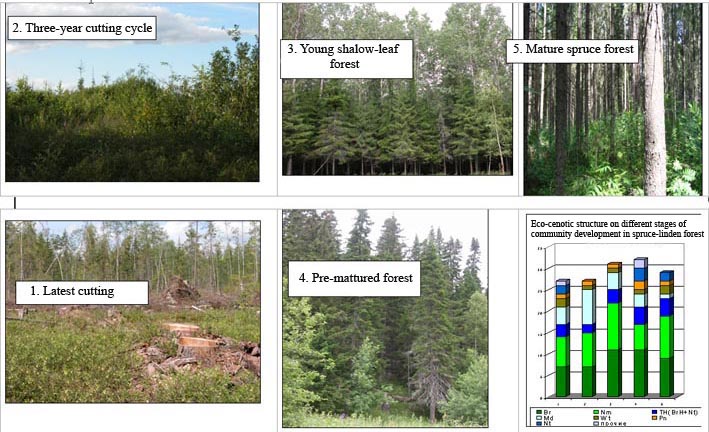
For this purpose the scientists of the CEPF RAS have discovered major attributes of climax forest ecosystems in European Russia as standards with optimal biodiversity parameters. There were established six groups of key species determining composition and structure of climax ecosystems (dark-coniferous and broad-leaved tree species, soil invertebrates – humificators, phyllophagous and xylophagous insects, wood-attacking fungi, big phytophagous mammals). Principles for assessment of succession changes of forest ecosystem were established in order to determine their difference from climax state. In order to determine the degree of succession changes researchers have developed the system of parameter values. Methodological approaches to biodiversity monitoring may be fulfilled at the base of cartographic and verbal reconstruction of potential forest vegetation of European Russia. It is based on theory on climax communities structure and on the mapping areas of edificator tree species and constant species of ground cover. The database was formed with using historical and contemporary information; while contemporary contour areas of broad-leaved and dark-coniferous species were compared with points of their location in historical time beyond their range boundaries. (fig. 2).
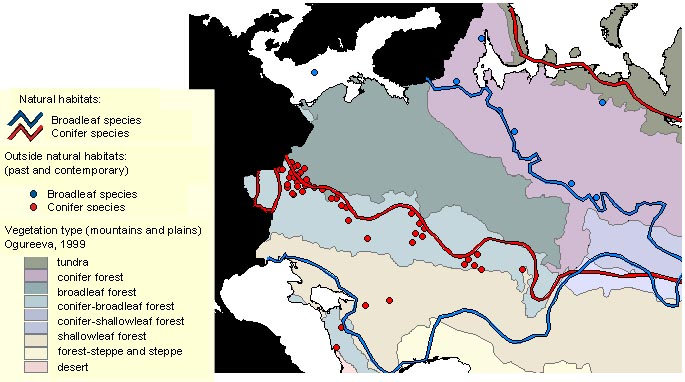
Historical and contemporary areas of tree species were compared; and the group of species was discovered; these species: beech, oak, hornbeam had essentially reduced their areas during last two or three centuries because of low tolerance to human impact. Also spotted maps of constant nemoral and boreal herbaceous species were composed; thus area of their common distribution was detected marking the range of mixed coniferous and broad leaved forests in historical time. Thus under spontaneous processes and free access of edificator tree seeds from refuges the extensive belt of dark-coniferous and broad-leaved (boreal-nemoral) forests may be restored within the greater part of Eastern Europe forest zone. This restoration will be rather complete in floristic relation because ground cover of secondary forests contains nemoral and boreal herbaceous and fruticulose species within this territory (CEPF RAS).
4. Using mathematical modeling methods
In order to research forest biodiversity different methods of mathematical analysis were used, allowing to normalize current processes and to forecast potential changes. Up to present time there hasn’t been phenomenological description of forest forming process in forest biogeocenology; but it is necessary to understand complicated interactions occurring in evolution of forest ecosystems. In order to study the steadiness of forest ecosystems scientists have proposed to use the method of phase portraits widely used in physics and theoretical ecology. The original phenomenological model has been developed which has allowed detecting laws of forest ecosystems forming during different reforestation stages and to explain environmental effects connected with forest cover dynamics in boreal zone. This is reached by composing, structuring and analyzing phase portraits; these portraits reflect dynamic processes of genesis, evolution and changes of forest communities within vast territories of taiga forests (fig. 3).
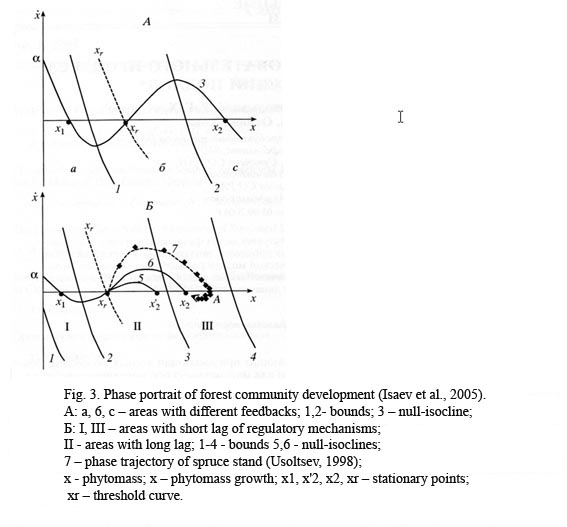
Theoretical analysis of these processes based on phenomenological approach is agreed with data of concrete field measurements and quantitative values (CEPF RAS, Forest Institute of the Siberian Department RAS).
For the purpose of biodiversity conservation within the framework of steady forest use it is important to create optimal nature management scenarios on the base of environmental and economic models. In order to forecast dynamics of biodiversity parameters under different forest management measures the mathematical model of forest ecosystems productivity was used (EFIMOD-PRO). Results of modeling are presented as series of maps (fig.4), based on data of forest inventory for one of model region. These maps allow analyzing the dynamics of vegetation diversity in according with landscape principles (CEPF RAS, The Institute of Physical and Chemical Problems of Soil Science RAS).
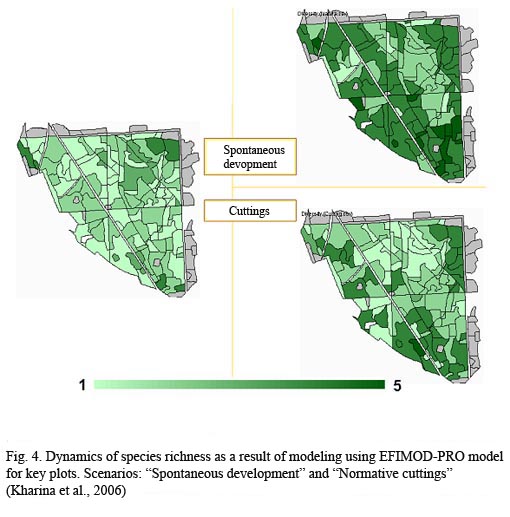
5. Development of procedure for monitoring of forest biodiversity
Accumulated scientific researches of biosystem diversity allowed beginning data interpretation in spatial units of different scale. During the Project’s fulfillment the CEPF scientists have developed main procedures of remote sensing monitoring of forest biodiversity. The whole complex of works includes the preliminary stage with forming cartographic data set, their subsequent processing, as well as collection of field data, processing of forest taxation data, remote sensing data, as well as interpolation of diversity indicators values for the area of higher topological level.
Using of digital model of relief and spectral brightness characteristics of ground cover received through scanner image due to procedures of their classification gives an opportunity to obtain contours differed in optical brightness and relief features. Further the average values of brightness, heights, slopes, shapes of surfaces are calculated for obtained types of contours.
Created “contour” base allow mapping vegetation with using ground botanical descriptions, while this base presents hierarchical arrangement of the territory and contemporary state of its ground cover and relief. As a result of interpolation due to multi-regression and discriminate analysis of space information and relief parameters the visualization of main forest features is carried out (tree species composition, closeness of tree crowns, age classes, species and ecosystem diversity and so on), accompanied by assessment of interpolation trustworthiness extent. Interpolated parameters are compared with contour base; thus the assessment of typological diversity of forest cover may be obtained. (fig. 5).
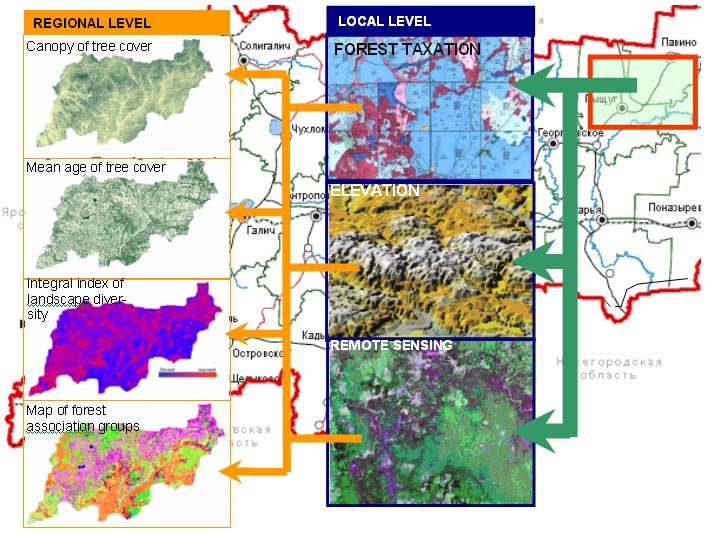
So, developed quantitative methods with using remote sensing data and digital relief model have based assessment of typological and landscape diversity of forest areas, presenting contemporary state of vegetation cover at regional level. Large-scale geobotanic descriptions add information about ecological and coenotic diversity of forest communities.
Space forest monitoring data are considered to be the most important component of information provision for monitoring and assessment of forest cover conditions. Remote sensing may detect such details, which can not be discovered under ground visual observations, or they would be very expensive. Satellite data are intended for control of natural and anthropogenic processes of low and middle temporary scale. Under large-scale survey these data may fix actively occurring processes (forest logging, pest invasions, accident pollution, oil contamination and so on.)
Using space data for assessment of Siberian forest diversity was widely developed in researches of V.N. Sukachev Forest Institute SD RAS. In particular, methods of remote sensing data processing were developed for creating vector maps of forest areas. Used for this purpose the non-clear composition method allow to generalize space image classified by computer, and to escape abundant class mosaic and thus to improve accuracy of combined analysis of raster remote sensing data and cartographic forest inventory information. Within framework of this method the algorithms were realized allowing analysis of spatial homogeneity of patterns, automatic formation of patterns and samples for thematic processing of space images: classification of tree species composition, assessment of phytomass and other biodiversity parameters.
6. Studies of regional aspects of biodiversity monitoring
Ideas about regional features of monitoring of forest ecosystem biodiversity were obtained for instance of model regions in different zonal and provincial conditions. Each region has as general features and individual specifics of processes determining forest biodiversity. Following factors: clear cuts, large forest fires, mass pest invasions and industrial contamination, have negatively impact on biodiversity. According to data of last forest inventory areas of burned forests and dead stands over the whole country 4 times more than area of non-forested cut areas. Every year only within actively protected territory (3/4 of forest fund) about 30 thousands forest fires appears damaging forests in area of 2-5 million ha. The most part of forests suffered of fires is concentrated in Siberia and Far East. The area of pest nidi and forest pathologies is about 3 million ha per year. During periods of mass pest propagation forests are destroyed within areas of hundreds of thousands hectares, especially in Siberia. Area of forests damaged by industrial emissions is about 1 million ha and it is constantly increasing especially in northwestern part of European Russia and in Eastern Siberia.
Researches and assessment of human impact on forest ecosystems have been carried out in Karelia, where the state of virgin forests was compared with the state of secondary forests in similar landscapes. These researches have established that clear cutting caused the cardinal transformation of biological diversity in forest ecosystems. The large areas of small-leaved forests occupy about some dozens of thousand hectares here and this is the most typical example of biodiversity transformation process. The figure 6 shows key territories (about 30 thou. ha area) with deeply transformed biogeocoenotic structure of forest cover; these territories are located within glacial hilly-ranged swamped landscape of middle taiga with prevailing spruce habitats.
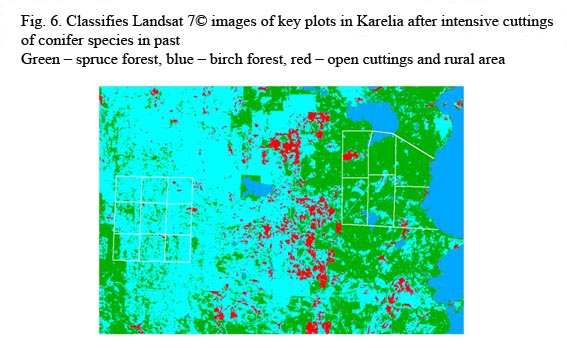
Serious human impact on forest cover is observed in Murmansk oblast, here at present forests present the mosaic of demutation successions after agricultural development, forest, cutting and so on. The CEPF RAS scientists have explored the features of post-fire and post-cutting reforestation successions. Within the zone of intensive industrial contamination the space-temporal digressive dynamics of forest areas has been researched. (fig. 7)
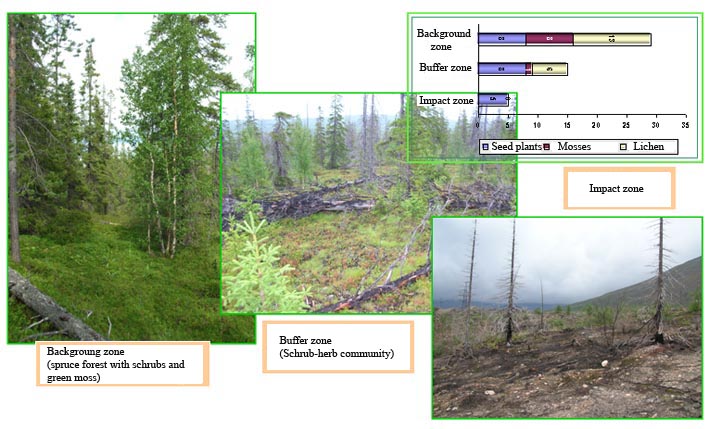
One of the results was concluded in the fulfilment of whole complex of works on assessment of degradation processes in vicinity of metallurgical enterprise by using main information sources (remote sensing data, forest taxation and field survey data).
7. Development of information maintenance
Efficiency of forest monitoring is determined to great extent by well-developed information base on the state and dynamics of forest fund, its environmental and resource potential, as well as knowledge about main conditions of forest ecosystem evolution. Creation of forest monitoring system supposes obligatory integration of information streams including space information. Within the framework of the Project the scheme of multi-level GIS for biodiversity of forest ecosystems has been developed, supporting fulfillment of inventory and assessment of nature conservation value of forest areas; because this is an important stage for composing forest cadastre in regional level (CEPF RAS) (fig. 8).
The integrate geoinformation system “Monitoring of forest biodiversity” is forming; within its framework the complex base of common informative materials on forest biodiversity has been created; also main digital cartographic data have been prepared for federal level and some model regions. The archive of high-permission (15-30 m) scanner images was formed for the whole territory of Russia for 1990-2000 years period. Using GIS-technologies provided integration and combined analysis of available vegetation data of different formats and scales; while new and complimentary information may be operatively integrated into the system (for example, remote sensing data, field surveys results, forest taxation materials). This is necessitate condition for forest monitoring, which is intended for obtaining operative assessment, analysis and forecasting state of the area.
So according to outlined tasks the complex methodological base for monitoring of biodiversity in boreal forests of Russia has been developed. This is based on conceptual approach to fulfillment of biodiversity monitoring with taking spatial-temporary dynamics of forest forming process and contemporary state of forests into account. The set of scientific and methodological tasks has been decided, providing use of available data on forest biodiversity in forest ecology, nature management and steady management by biological resources. The most part of methods and approaches to assessment of state and monitoring of forest biodiversity were tested in model regions. Obtained results were interpreted in some publications and monographs.
Results of the Project’s works had served to creating web-site “Development of methodological bases for monitoring of forest biodiversity” - http://mfd.cepl.rssi.ru. The site contains the information about the RAS Presidium Fundamental Research Program “Scientific bases for conservation of biodiversity in Russia”, an information about the Project “Development of methodological bases for monitoring of forest biodiversity”, an information about participants and partner institutions, main results of the Project. Some scientific papers and monographs have been prepared. (Appendixes 1, 2).
Perspectives of further researches
- Working out methods of biodiversity monitoring on the base of ground surveys and satellite information
- Inventory of typological diversity of forest ecosystems in boreal zone
- Improvement of quantitative methods of ecosystem diversity assessment for forest areas
- Development of methods for assessment of past, contemporary and potential biological diversity of forest vegetation
- Development of methods for prognosis and algorithms for account of forest biodiversity dynamics under different scenarios of nature management
- Development of strategy for conservation of ecosystem and landscape diversity
References
Isaev A.S., Sukhovolsky V.G., Khlebopros R.G. et al. Modeling forest forming process – phenomenological approach // Lesovedenie,1, 2005. p. 3-12.
Zaugol’nova L.B., Morozova O.V. Typology and classification of European Russia forests: methodic approaches and their realization // Lesovedenie,. № 6. 2006.
Malyshev L.I. Floristic richness of the USSR // Actual problems of comparative study of floras. St-Ptsb.: Nauka, 1994. P. 34-87.
Magarran E. Ecological diversity and its measurement. M.: Mir, 1992. 184 p.
Usoltsev V.A. Forming databases on forest phytomass. Ekaterinburg, Urals Department of RAS, 2001. 709 p.
Smirnova O.V., Bakun E.Yu., Turubanova S.A. Concept of potential and restored vegetation cover of forests and its realization for example of East European forest belt // Lesovedenie, 2006, №1.
Khanina L.G., Bobrovsky M.V., Komarov A.S. et al. Modeling dynamics of forest ground cover diversity // Lesovedenie, 1, 2006.
Allen T.F., Starr T.B. Hierarchy: perspectives for ecological complexity. University of Chicago Press, IL. 1982. 310 p.
Franklin J. F. Structural and functional diversity in temperate forests// Biodiversity. Washington: Nat. Acad. Press, 1988. P. 166-175.
Heywood V.H. 1995. Global Diversity Assessment. UNEP. Cambridge University Press, Cambridge.
Zonneveld I. S. 1988. Landscape ecology and its application. In: Landscape Ecology and Management. pp. 3–15. Edited by M.R. Moss. Polyscience Publications Inc., Montreal, Canada.
Whittaker R.H.. Evolution and measurement of species diversity. Taxon 21, 1972. Р. 213-251.
